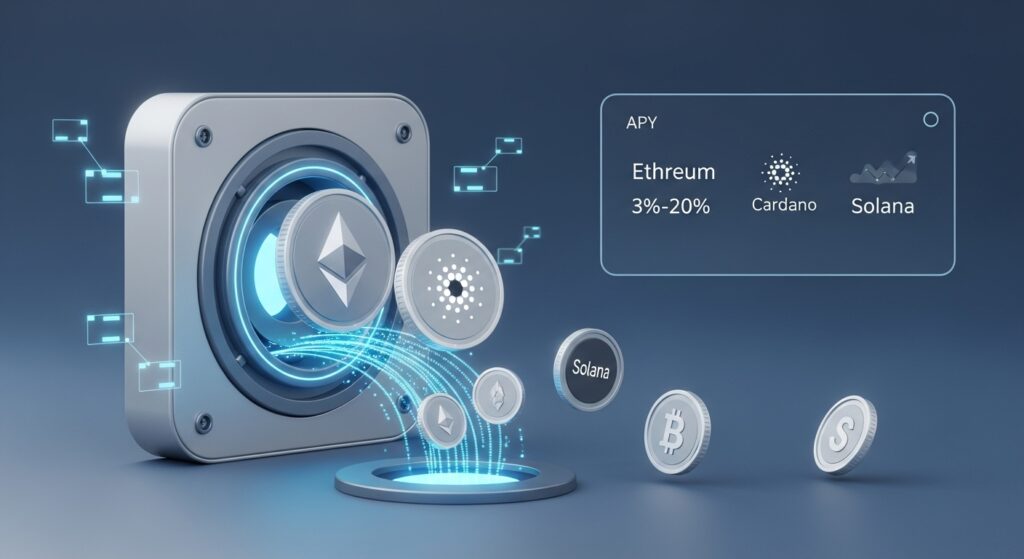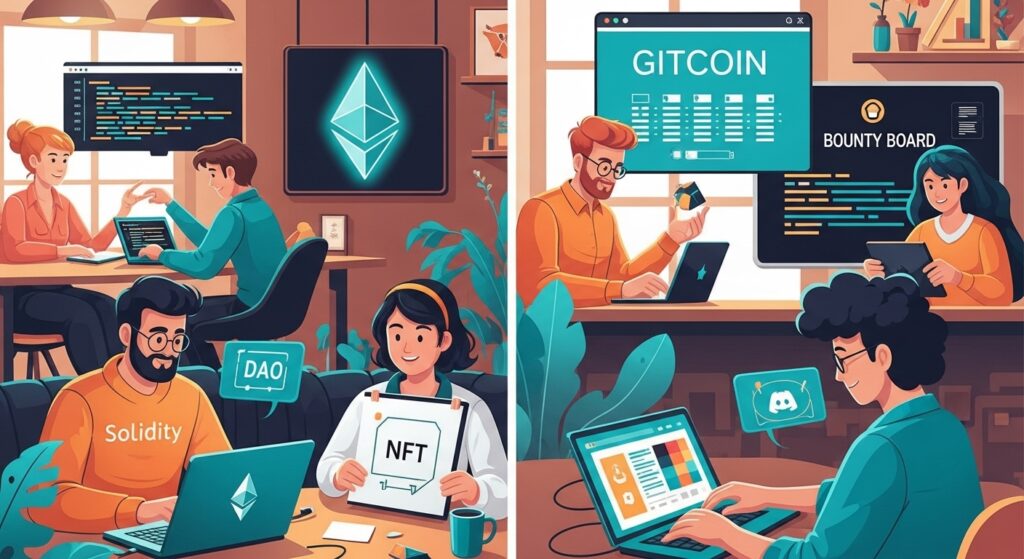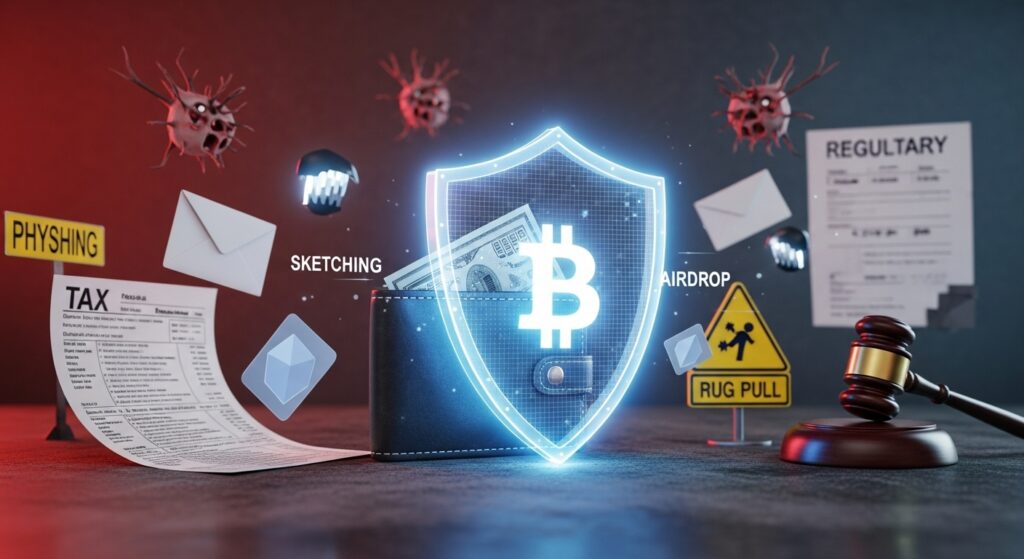Crypto and blockchain aren’t just buzzwords for tech bros or Wall Street wannabes—they’re a wild, open playground where anyone with some hustle and curiosity can make a buck. Whether you’re a trader chasing the next Bitcoin pump, an artist minting pixelated cats, or just someone who wants to explain DeFi to your confused uncle for a fee, there’s a way to get in on the action. No PhD or trust fund required—just a willingness to learn, a bit of paranoia (trust me, you’ll need it), and a knack for dodging scams. This guide breaks down the legit ways to make money in the crypto world, from trading to teaching, with practical tips to keep you from getting burned. Let’s dive into the great blockchain gold rush!
Cryptocurrency Investing & Trading

Crypto trading and investing are the OGs of making money in this space—like playing the stock market but with more memes, crazier swings, and 24/7 action. It’s thrilling, but it’s also a fast track to losing your shirt if you’re just winging it. Here’s the breakdown.
Investing is the chill route: buy coins like Bitcoin or Ethereum, stash them in a wallet, and hope they moon someday. It’s called “HODLing” (born from a drunk Reddit post misspelling “hold”)—basically, stubborn optimism that blockchain will take over the world. Early HODLers who bought Bitcoin at $100 are now sipping piña coladas on yachts, but don’t expect that luck today. Still, long-term bets on solid projects like Ethereum or Solana can pay off if you’re patient and the market doesn’t tank.
Trading is for those who thrive on chaos. Crypto markets never close, so you’re always on. Here’s a quick comparison of trading styles:
| Trading Style | Timeframe | Pros | Cons | Best For |
|---|---|---|---|---|
| Day Trading | Minutes to hours | Fast profits, high control | Stressful, time-intensive, high risk | Risk-takers with time and tech skills |
| Swing Trading | Days to weeks | Less time-consuming, catches trends | Requires market knowledge, emotional swings | Patient traders with moderate time |
| Arbitrage | Seconds to minutes | Exploits price gaps across exchanges | Needs speed, tech setup, and low fees | Tech-savvy hustlers with fast execution |
To trade well, you need to master technical analysis—those candlestick charts and squiggly lines that look like a toddler’s doodles but actually predict price moves (sometimes). Learn terms like “support,” “resistance,” and “RSI” from free resources like Binance Academy. But here’s the real talk: trading is an emotional rollercoaster. One bad move, and you’re rage-tweeting; one good one, and you’re dreaming of Lambos. Most newbies get wrecked without a plan.
Where to start? Centralized exchanges (CEXs) like Coinbase or Binance are beginner-friendly, with slick apps and customer support. Decentralized exchanges (DEXs) like Uniswap give you more freedom but require a wallet like MetaMask and some tech know-how. New to this? Try paper trading (fake money, real practice) to test your skills without crying over lost cash.
For the lazy or risk-averse, crypto index funds or ETFs (if legal in your country) bundle top coins like a Spotify playlist, spreading your risk. Check CoinMarketCap for market trends and fund options. Trading bots sound cool—set it, forget it, sip margaritas—but a bad bot just loses money faster. They’re tools, not magic.
Risk management is non-negotiable. Diversify (mix DeFi, NFTs, infrastructure coins). Use stop-loss orders to cap losses. Never bet more than you can afford to lose—seriously, don’t YOLO your rent money. And beware the hype: new coins pop up daily, but most are scams or duds. “Do your own research” (DYOR) isn’t just a meme—it’s survival. Start small, study hard, and you might just outsmart the market.
Also Read –
- How can I monetize my blog or my social network audience?
- What Are the Most Effective Ways to Earn Money Online in 2025?
- How to Earn Money from Online Platforms in 2025
Staking & Yield Farming – Making Crypto Actually Do Something

Trading too stressful? Staking and yield farming are the crypto equivalent of a high-yield savings account—your coins earn money while you chill. They’re part of DeFi (decentralized finance), where code replaces banks, and you get to play banker. Here’s how they work.
Staking means locking up coins like Ethereum, Cardano, or Solana to secure a blockchain network, earning interest (usually in the same coin). It’s like renting out your car for passive income. Big platforms make it easy—check out this comparison:
| Platform | Supported Coins | Typical APY | Lockup Period | Ease of Use |
|---|---|---|---|---|
| Coinbase | ETH, ADA, SOL | 3-8% | None to weeks | Beginner-friendly, one-click |
| Kraken | ETH, DOT, ATOM | 4-12% | Varies (7-28 days) | User-friendly, reliable |
| Ledger (via wallet) | ETH, SOL, ADA | 5-15% | Varies | Advanced, full control |
| Binance | Multiple (ETH, BNB) | 5-20% | Flexible or fixed | Wide options, some complexity |
Find more options on Staking Rewards. Use exchanges for simplicity or wallets like Ledger for control, but pick a solid validator to avoid slashing (losing coins if they screw up). APYs range from 3% to 20%, depending on the network and timing—not life-changing, but great for HODLers.
Yield farming is staking’s wild cousin. You supply liquidity to a pool on platforms like Uniswap or PancakeSwap—say, pairing ETH with USDC—and earn a cut of trading fees, plus bonus tokens sometimes. It’s like running a lemonade stand where traders pay to sip. APYs can hit 20%, 50%, even 100% in crazy times, but here’s the catch: impermanent loss. If one coin in your pair moons or tanks, you might lose more than you gain compared to just holding. Check DeFi Pulse for top protocols.
Both have risks. Staking might lock your coins for weeks, so no quick cash-outs. Yield farming’s smart contracts can get hacked—poof, money gone. Stick to audited projects and diversify. Don’t chase 1000% APYs; they’re usually scams or “rug pulls” where devs vanish with your funds. Tools like Yearn Finance automate yield chasing, but they’re not foolproof.
The beauty? You’re powering the blockchain while earning. Staking supports network security; yield farming fuels trading. It’s passive income with a revolutionary twist—just keep your eyes open and don’t bet the farm.
Blockchain Development & Freelancing – Making Money with Skill, Not Just Cash

Not into gambling your savings? Use your skills instead. The crypto industry is starving for talent—coders, designers, writers, meme lords, you name it. Blockchain gigs are remote, flexible, and often pay in crypto (which can be a rollercoaster, but also a flex). Here’s how to cash in.
Blockchain developers are the rockstars. If you code in Solidity (Ethereum), Rust (Solana), or even JavaScript, you’re in demand. Build smart contracts (self-executing code) or dApps (decentralized apps like Uniswap), and you’re golden. No experience? Start with Gitcoin bounties—fix a bug, earn ETH. Hackathons from Ethereum Foundation or Chainlink offer cash prizes and sometimes jobs. Even web devs can pivot to Web3, tweaking frontends for blockchain apps.
Not a coder? No problem. Crypto startups need content creators who can explain DeFi without jargon, designers for slick NFT art, and community managers to tame Discord chaos. Check CryptoJobs for gigs—full-time, part-time, or one-off meme contests. DAOs (decentralized autonomous organizations) like BanklessDAO pay for contributions like writing or governance proposals, often in their own tokens. It’s speculative but fun.
Want to teach? Run a newsletter on Mirror, sell a crypto course on Teachable, or host a paid Discord group. Got a niche like NFTs or privacy coins? Package it and charge for access. The crypto world loves knowledge, and people pay for clarity.
The catch? Crypto payments swing wildly—ETH might tank mid-gig. Taxes are a nightmare; track everything. Some projects ghost or turn out to be scams. Vet clients, diversify income, and keep some fiat for bills. Still, Web3 is a freelancer’s dream: no gatekeepers, global clients, and a chance to shape the future. One solid contribution, and you’re in the club.
NFTs, Play-to-Earn & the Metaverse – Where Creativity Gets Paid, Kinda

Heard about the $69 million JPEG or the kid who made bank playing crypto games? Welcome to NFTs, play-to-earn (P2E), and the metaverse—where creativity pays, and the rules are weird. Let’s unpack it.
NFTs (non-fungible tokens) are unique digital assets—a drawing, song, or virtual sneaker—stored on the blockchain. Artists sell directly to fans on OpenSea, no gallery needed, and can earn royalties on resales. The 2021 NFT craze is over; buyers now want quality or utility (like event access). Here’s a comparison of top marketplaces:
| Marketplace | Transaction Fees | Key Features | Best For |
|---|---|---|---|
| OpenSea | 2.5% | Largest selection, supports multiple chains | Beginners, diverse NFTs |
| Rarible | 2.5% | Community governance, RARI token rewards | Artists seeking royalties |
| Blur | 0-0.5% | Fast trading, aggregator for pros | Advanced traders |
Play-to-earn games flip gaming upside down. Instead of paying to play, you earn tokens or NFTs for battling, questing, or grinding. Axie Infinity had folks in the Philippines out-earning their day jobs fighting cartoon critters, but its token crashed when hype faded. Newer games like Illuvium aim for actual fun, not just profit. Can’t afford pricey in-game NFTs? Try scholarships—someone lends you assets, you play, and you split the earnings.
The metaverse is virtual land grabs on steroids. In worlds like The Sandbox, people buy digital plots, host events, or rent them for ads. Brands like Adidas are already there, and Snoop Dogg’s throwing virtual concerts. Prices are volatile, though—one day your land’s worth a fortune, the next it’s digital dirt.
Risks? Oh, plenty. NFT markets crash, games flop, and scams are everywhere. Focus on projects with real use cases—does that NFT unlock cool perks? Is that game actually fun? Creativity rules here. Whether you’re an artist, gamer, or storyteller, there’s a niche for you. Just don’t bet your life savings on a cartoon monkey.
Education, Content Creation & Consulting – Teaching the Blockchain Revolution

Not everyone wants to trade or code. Some just want to explain crypto—and that’s a goldmine. Most people still think “blockchain” is just Bitcoin, and they’ll pay for clarity. If you can break down gas fees or tokenomics without sounding like a robot, you’re already ahead.
Content creation is hot. YouTube explainer videos, TikTok crypto tips, or Twitter threads on DeFi can pull in ad revenue, sponsors, or Patreon bucks. Build a following, and you’ve got a business. Want to go bigger? Create a course on ConsenSys Academy or Teachable, or sell a newsletter on Mirror. NFTs can even gate exclusive content—Web3 style.
Consulting is where skills meet strategy. If you know finance, law, or marketing and crypto, companies will beg for your brain. Advise a DAO on governance, help a bank launch a blockchain project, or explain NFTs to a brand. It’s global—Zoom with a DeFi team in Seoul, then an artist in L.A. No crypto knowledge yet? Learn the basics and pair it with your expertise.
Local education is underrated. Artists, farmers, or small biz owners need hands-on blockchain workshops. Grants often fund these, especially for financial inclusion. Be the bridge between Web2 and Web3.
The key? Build trust. Crypto’s full of “gurus” selling snake oil. Be honest, transparent, and deliver value. A solid rep opens doors—clients, speaking gigs, even DAOs. Your voice matters, and people will pay to hear it.
Risks, Regulations & Best Practices – Navigating the Crypto Minefield

Crypto’s a gold rush, but scams, hacks, and regulations can wipe you out. Here’s how to stay safe, with common scams to watch for:
| Scam Type | What It Is | Red Flags | How to Avoid |
|---|---|---|---|
| Phishing | Fake links steal your wallet | Random DMs, urgent “claim now” messages | Never click unsolicited links, verify URLs |
| Rug Pull | Devs hype project, then vanish | Anonymous team, unaudited code | Research team, check audits |
| Fake Airdrops | Free coins for clicking | Asks for seed phrase or wallet connect | Never share seed phrase, use burner wallets |
| Pump & Dump | Hype drives price, then crash | Shilling on social media, no real use case | DYOR, avoid “guaranteed 100x” claims |
Scams exploit crypto’s anonymity. Rug pulls are rampant in DeFi and NFTs—vet projects hard. Are devs doxxed? Is code audited? Does it do anything useful? If not, pass. Never share your seed phrase, even if “Elon Musk” DMs you.
Regulations are a mess. In the U.S., every trade is taxable, even coin-to-coin swaps. Other countries have their own rules—some ban DeFi outright. Freelancers, track your crypto payments with tools like CoinTracker to avoid tax nightmares. Hacks or losses? You’ll need proof for deductions. Check local laws before diving in.
Best practices: Use a hardware wallet (like Ledger) for long-term storage. Enable two-factor authentication (2FA) everywhere. Diversify—don’t put all your eggs in one coin or platform. Track trades and stay updated via CryptoSlate for news on scams and regulations. Crypto moves fast—today’s hot project could be tomorrow’s ban.
Stay paranoid but not frozen. With smarts and caution, you can dodge the traps and keep stacking coins.
Conclusion

Crypto and blockchain aren’t just for nerds or early adopters anymore. Whether you’re trading, staking, building dApps, minting NFTs, or teaching newbies, there’s a way to make your mark. It’s not “get rich quick”—it’s “get curious quick.” The space evolves fast: tokens tank, platforms vanish, and governments throw curveballs. But that’s the thrill.
You don’t need to be a genius. Start small—stake some ETH, join a DAO, post a crypto explainer, or play a P2E game. Ask dumb questions, break stuff, learn, repeat. The real win isn’t just coins—it’s the skills, connections, and chance to shape a new financial world. Dive in, stay sharp, and check Messari to keep learning. The future’s yours if you’re bold enough to grab it.
FAQs
How can beginners make money with cryptocurrency?
Start with crypto investing in Bitcoin or Ethereum on Coinbase or staking on Kraken (3-8% APY). Practice trading on TradingView to avoid risks. Research on CoinMarketCap to dodge scams.
Is crypto trading riskier than stocks?
Yes, crypto trading has higher volatility and 24/7 markets. Use stop-loss orders, diversify (DeFi, NFTs), and learn technical analysis on Binance Academy to trade smarter.
What’s the difference between staking and yield farming?
Staking locks coins (e.g., ETH on Ledger) for 3-15% APY with low risk. Yield farming on Uniswap offers 20-100% APY but risks impermanent loss. Check Staking Rewards for options.
Can I earn crypto without investing money?
Yes! Try blockchain freelancing on Gitcoin, content creation on Mirror, or play-to-earn games like Axie Infinity. Join DAOs like BanklessDAO for paid Web3 tasks.
Are NFTs and the metaverse profitable in 2025?
Yes, NFTs on OpenSea with utility and metaverse projects like The Sandbox can profit. Avoid hype; verify contracts on Etherscan to ensure safe investments.
How do I avoid crypto scams?
Never share your seed phrase, skip shady airdrops, and use Ledger wallets with 2FA. Research projects on RugDoc and track regulations via CryptoSlate to stay safe.



